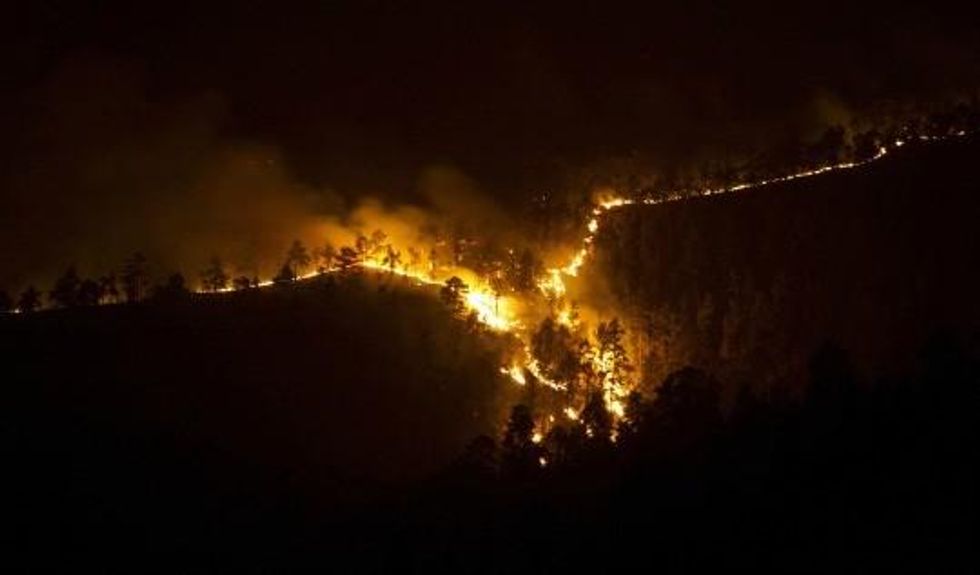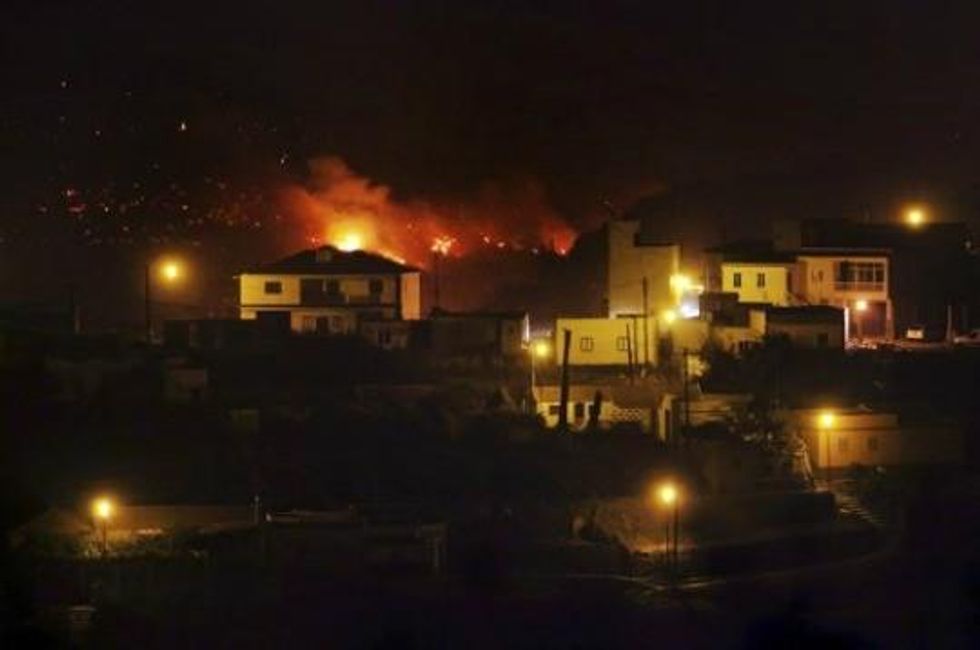

SUBSCRIBE TO OUR FREE NEWSLETTER
Daily news & progressive opinion—funded by the people, not the corporations—delivered straight to your inbox.
5
#000000
#FFFFFF
To donate by check, phone, or other method, see our More Ways to Give page.


Daily news & progressive opinion—funded by the people, not the corporations—delivered straight to your inbox.

"High temperatures, low humidity and wind" have continued to feed the flames as firefighters find themselves losing the battle, regional economy minister Javier Gonzalez Ortiz said on Saturday.
Both extreme and unusual heat and drought have lead to a country plagued by wildfires, as fires also continued to rage in several regions on the Spanish mainland. This year Spain experienced its driest winter in 70 years. Between January 1 and July 29, wildfires destroyed 130,830 hectares of vegetation across Spain.
On the island of La Gomera alone some 3,000 hectares of land, including about one-tenth of the Garajonay nature reserve, a UNESCO World Heritage site, have been devastated.
"The fires are still burning on three fronts," an emergency services spokesperson said earlier. "There is no positive change for the moment."
Ventura del Carmen Rodriguez, the island's environment secretary, stated it would take 30-40 years for Garajonay's burned areas to recover. The Garajonay reserve hosts highly rare subtropical forests containing up to 450 plant species, including eight exclusive to the site.

Dear Common Dreams reader, The U.S. is on a fast track to authoritarianism like nothing I've ever seen. Meanwhile, corporate news outlets are utterly capitulating to Trump, twisting their coverage to avoid drawing his ire while lining up to stuff cash in his pockets. That's why I believe that Common Dreams is doing the best and most consequential reporting that we've ever done. Our small but mighty team is a progressive reporting powerhouse, covering the news every day that the corporate media never will. Our mission has always been simple: To inform. To inspire. And to ignite change for the common good. Now here's the key piece that I want all our readers to understand: None of this would be possible without your financial support. That's not just some fundraising cliche. It's the absolute and literal truth. We don't accept corporate advertising and never will. We don't have a paywall because we don't think people should be blocked from critical news based on their ability to pay. Everything we do is funded by the donations of readers like you. Will you donate now to help power the nonprofit, independent reporting of Common Dreams? Thank you for being a vital member of our community. Together, we can keep independent journalism alive when it’s needed most. - Craig Brown, Co-founder |

"High temperatures, low humidity and wind" have continued to feed the flames as firefighters find themselves losing the battle, regional economy minister Javier Gonzalez Ortiz said on Saturday.
Both extreme and unusual heat and drought have lead to a country plagued by wildfires, as fires also continued to rage in several regions on the Spanish mainland. This year Spain experienced its driest winter in 70 years. Between January 1 and July 29, wildfires destroyed 130,830 hectares of vegetation across Spain.
On the island of La Gomera alone some 3,000 hectares of land, including about one-tenth of the Garajonay nature reserve, a UNESCO World Heritage site, have been devastated.
"The fires are still burning on three fronts," an emergency services spokesperson said earlier. "There is no positive change for the moment."
Ventura del Carmen Rodriguez, the island's environment secretary, stated it would take 30-40 years for Garajonay's burned areas to recover. The Garajonay reserve hosts highly rare subtropical forests containing up to 450 plant species, including eight exclusive to the site.


"High temperatures, low humidity and wind" have continued to feed the flames as firefighters find themselves losing the battle, regional economy minister Javier Gonzalez Ortiz said on Saturday.
Both extreme and unusual heat and drought have lead to a country plagued by wildfires, as fires also continued to rage in several regions on the Spanish mainland. This year Spain experienced its driest winter in 70 years. Between January 1 and July 29, wildfires destroyed 130,830 hectares of vegetation across Spain.
On the island of La Gomera alone some 3,000 hectares of land, including about one-tenth of the Garajonay nature reserve, a UNESCO World Heritage site, have been devastated.
"The fires are still burning on three fronts," an emergency services spokesperson said earlier. "There is no positive change for the moment."
Ventura del Carmen Rodriguez, the island's environment secretary, stated it would take 30-40 years for Garajonay's burned areas to recover. The Garajonay reserve hosts highly rare subtropical forests containing up to 450 plant species, including eight exclusive to the site.
